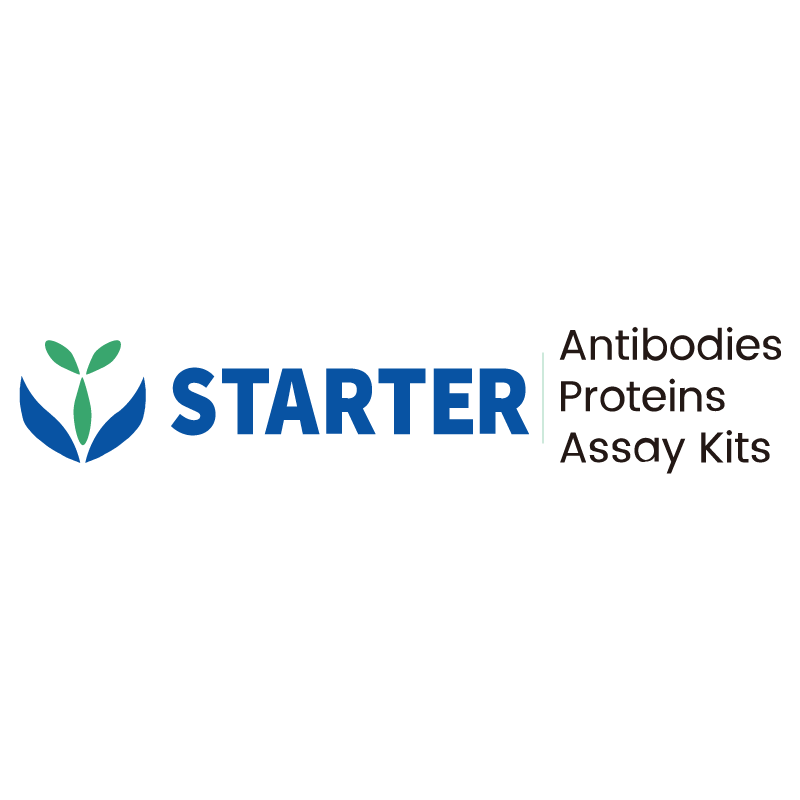WB result of CRX Recombinant Rabbit mAb
Primary antibody: CRX Recombinant Rabbit mAb at 1/1000 dilution
Lane 1: mouse kidney lysate 20 µg
Lane 2: mouse eye lysate 20 µg
Negative control: mouse kidney lysate
Secondary antibody: Goat Anti-rabbit IgG, (H+L), HRP conjugated at 1/10000 dilution
Predicted MW: 32 kDa
Observed MW: 37 kDa
This blot was developed with high sensitivity substrate
Product Details
Product Details
Product Specification
| Host | Rabbit |
| Antigen | CRX |
| Synonyms | Cone-rod homeobox protein; CORD2 |
| Immunogen | Synthetic Peptide |
| Location | Nucleus |
| Accession | O43186 |
| Clone Number | SDT-2194-105 |
| Antibody Type | Recombinant mAb |
| Isotype | IgG |
| Application | IHC-P |
| Reactivity | Hu, Ms, Rt |
| Predicted Reactivity | Bv, Dg, Gor, Cz, GP |
| Purification | Protein A |
| Concentration | 0.5 mg/ml |
| Conjugation | Unconjugated |
| Physical Appearance | Liquid |
| Storage Buffer | PBS, 40% Glycerol, 0.05% BSA, 0.03% Proclin 300 |
| Stability & Storage | 12 months from date of receipt / reconstitution, -20 °C as supplied |
Dilution
| application | dilution | species |
| WB | 1:1000 | Ms |
| IHC-P | 1:1000 | Hu, Ms, Rt |
Background
CRX (Cone-Rod Homeobox) is a 299-amino-acid photoreceptor-specific transcription factor of the OTX-like homeodomain family, encoded by the CRX gene on 19q13.32, that binds to and trans-activates promoters and enhancers of rod and cone photoreceptor genes—including rhodopsin, OPN1SW, OPN1MW, PDE6 subunits and arrestin—via the PCE (photoreceptor conserved element) motif, thereby orchestrating the development, differentiation and daily maintenance of outer-segment structure and phototransduction; autosomal-dominant mutations—missense, truncating, or C-terminal frameshift—cause a spectrum of retinal dystrophies such as cone-rod dystrophy-2, Leber congenital amaurosis-7 and retinitis pigmentosa, while CRX haploinsufficiency or dominant-negative interference disrupts transcriptional networks synergistic with OTX2 and NRL, leading to progressive photoreceptor degeneration and visual impairment.
Picture
Picture
Western Blot
Immunohistochemistry
IHC shows positive staining in paraffin-embedded human retina. Anti-CRX antibody was used at 1/1000 dilution, followed by a HRP Polymer for Mouse & Rabbit IgG (ready to use). Counterstained with hematoxylin. Heat mediated antigen retrieval with Tris/EDTA buffer pH9.0 was performed before commencing with IHC staining protocol.
Negative control: IHC shows negative staining in paraffin-embedded human kidney. Anti-CRX antibody was used at 1/1000 dilution, followed by a HRP Polymer for Mouse & Rabbit IgG (ready to use). Counterstained with hematoxylin. Heat mediated antigen retrieval with Tris/EDTA buffer pH9.0 was performed before commencing with IHC staining protocol.
IHC shows positive staining in paraffin-embedded mouse retina. Anti-CRX antibody was used at 1/1000 dilution, followed by a HRP Polymer for Mouse & Rabbit IgG (ready to use). Counterstained with hematoxylin. Heat mediated antigen retrieval with Tris/EDTA buffer pH9.0 was performed before commencing with IHC staining protocol.
Negative control: IHC shows negative staining in paraffin-embedded mouse kidney. Anti-CRX antibody was used at 1/1000 dilution, followed by a HRP Polymer for Mouse & Rabbit IgG (ready to use). Counterstained with hematoxylin. Heat mediated antigen retrieval with Tris/EDTA buffer pH9.0 was performed before commencing with IHC staining protocol.
IHC shows positive staining in paraffin-embedded rat retina. Anti-CRX antibody was used at 1/1000 dilution, followed by a HRP Polymer for Mouse & Rabbit IgG (ready to use). Counterstained with hematoxylin. Heat mediated antigen retrieval with Tris/EDTA buffer pH9.0 was performed before commencing with IHC staining protocol.
Negative control: IHC shows negative staining in paraffin-embedded rat kidney. Anti-CRX antibody was used at 1/1000 dilution, followed by a HRP Polymer for Mouse & Rabbit IgG (ready to use). Counterstained with hematoxylin. Heat mediated antigen retrieval with Tris/EDTA buffer pH9.0 was performed before commencing with IHC staining protocol.


